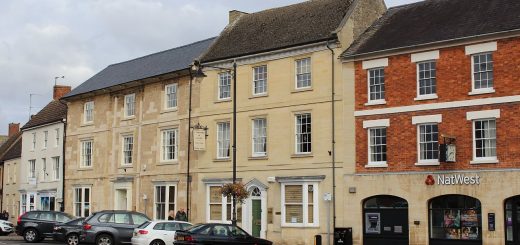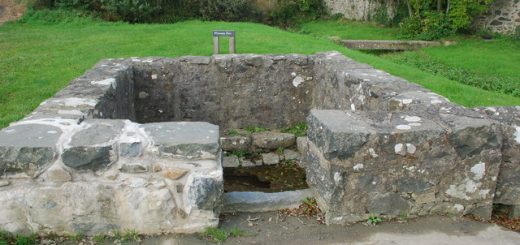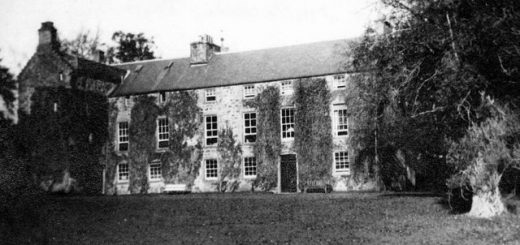St Mullins Monastery and Holy Well
Originally known as Rinn Ros Broic (Badgers Wood Point), Kennedy’s Field and Achadh-Cainidh, St Mullins is the site where St Moling built his monastery during the 7th Century. It was reputedly built by Cobban the Wright (Cobban Saer) and the roof of the oratory was said to have been made from wood taken from the Eo Rossa (Yew of Ross) which was one of Irelands five sacred trees.
![Sarah777 [CC BY-SA 3.0 (https://creativecommons.org/licenses/by-sa/3.0)], from Wikimedia Commons](http://www.mysteriousbritain.co.uk/wp/wp-content/uploads/2018/12/St._Mullins-300x200.jpg) The monastery is now long gone, though the remains of St Molings cell and four chapels remain. St Mullins is also famous for its Holy Well (the earliest mention of this is in the 1348 Annals of Friar Clyn but it is considered to date from the time of St Moling) a popular place of pilgrimage on 17 June (St Molings Feast Day) and the Sunday closest to 25 July (Pattern Day). It was described in 1839 as being ‘10 or 12 feet in diameter, planted round with ash trees’ (Ordnance Survey). Thousands of pilgrims would partake of the water and follow a prescribed route around the well and wading into the stream. Prayers would then be said amongst the four ruined chapels at the site and Mass would be taken on the Penal altar before alms would be distributed to the poor.
The monastery is now long gone, though the remains of St Molings cell and four chapels remain. St Mullins is also famous for its Holy Well (the earliest mention of this is in the 1348 Annals of Friar Clyn but it is considered to date from the time of St Moling) a popular place of pilgrimage on 17 June (St Molings Feast Day) and the Sunday closest to 25 July (Pattern Day). It was described in 1839 as being ‘10 or 12 feet in diameter, planted round with ash trees’ (Ordnance Survey). Thousands of pilgrims would partake of the water and follow a prescribed route around the well and wading into the stream. Prayers would then be said amongst the four ruined chapels at the site and Mass would be taken on the Penal altar before alms would be distributed to the poor.
Legend of the Founding of St Mullins
Brénainn (St Brendan) started to build a monastery at Rinn Ros Broic by the Barrow after catching salmon with three successive throws of a net into the river. He was prevented by an Angel who said “Do not make an abode here now, for in prophecy it is not for thee to make an abode here; but the boy who will be born at the end of thirty years from to-day, he it is, Moling of Linn mor, that will make a dwelling there. And tis he that will settle at the Point of Ros Broic on the brink of the Barrow, and tis a multitude that he will bring to heaven. And there he will perform his miracles and his marvels, and his Lord will come to converse with him in the guise of a leper.” Brénainn had already built the hearth, but stopped building the rest of his church as advised by the Angel.
Thirty years later, Moling (then a young priest) visited King Fingin, son of Aed at Cashel and was granted permission from the King to build an abbey church. Then an Angel approached Moling saying “What business hast thou to be asking a place here, while there is a place ready for thee by the streampools of the Barrow, and a fire alive for thirty years there awaiting thee? (This referred to the hearth built by Brénainn and abandoned in favour of Moling) And build thy church and thy patron saints temple there and serve thy Lord therein.”
Fingin had overheard the conversation between Moling and the Angel and urged the young monk to seek out the location mentioned by the Angel and promised to give him all the help he required. Moling found the location of Brénainn’s hearth and though the location had a reputation for robbery and theft and outrage, he built his church. The site of this monastery is now known as St Mullins.
At this time there were five sacred trees in Ireland, the bileda, each having grown from three natured berries from a branch born by the Irish God, Trefuilngid Tre-ochair (Triple Bearer of the Triple Key, Master of All Wisdom and consort of Macha, the triple goddess.) They were old trees and subjects of pre-Christian worship. One of these sacred trees of the old religion, the Eo Rossa (Yew of Ross) grew at Leighlenbridge on the River Barrow in County Carlow and had been recently felled. St Molaisse distributed this wood amongst the Irish Saints and Moling approached him seeking some of the limbs of the tree for the roof of his oratory. Moling employed Gobban the Wright (Cobban Saer) to construct his oratory for him.
Burials at St Mullins are said to include the Kavanagh Kings of Leinster who saw St Moling as the patron of Clan Kavanagh. Also St Moling (died 696AD) and Suibne Geilt (Sweeney the Frenzied or Madman), King of the Pictish Kingdom of Dal nAraide (6-7th Century)
The tomb of Rev Daniel Kavanagh found in front of the Penal altar is associated with a cure for toothache. It is said that you must take a piece of clay from outside of the cemetery. Place this piece of clay under the tomb of Rev Daniel Kavanagh. Remove a piece of clay from under the tomb and place it in your mouth, then wash the clay from your mouth at the Holy Well. After offering a prayer to Rev Daniel Kavanagh and your toothache will be cured. (Time for a disclaimer. Mysterious Britain & Ireland does not advise that you try this and we are not giving any sort of medical advice).




Recent Comments